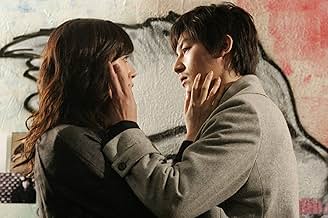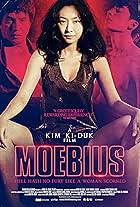To save her relationship, a woman puts herself through extensive plastic surgery.To save her relationship, a woman puts herself through extensive plastic surgery.To save her relationship, a woman puts herself through extensive plastic surgery.
- Awards
- 3 wins & 2 nominations
- Director
- Writer
- All cast & crew
- Production, box office & more at IMDbPro
Storyline
Did you know
- TriviaThe film Ji-woo edits is "3 Iron", an actual film directed by Ki-Kim duk.
- ConnectionsFeatures 3-Iron (2004)
- SoundtracksDays Of Wine And Roses
Written by Henry Mancini and Johnny Mercer
Featured review
A poet said that there are 3 types of love: First for a REASON... You love someone for a reason(because she's beautiful,because she's special etc.) Second is to love AS... You love someone as good as she loves you,as much as you love your mum, etc. Third is to love DESPITE... Despite she's ugly, despite she's moody, despite she's lighthearted, etc. Then he added, to truly love someone is to accept her/his nature with pros and cons altogether.
In Kim Ki-duk's "Shi gan(Time)" the whole plot is based on a Korean couple who are at their mid-20s. Even though, they're getting prepared to marry, they don't realize that their relation is still relying on reasons. Like every fresh couple, since they don't express their needs and wishes to each other, their harmony goes downhill by time. Seh-Hee surprisingly leaves her lover without any warning or explanation due to her jealousy on him. She decides to have a plastic surgery to get a more beautiful face than she has. That way, when she comes back, she'll feel more comfortable for securing her love through her beauty. In other words, she leaves him for the shortfall of trust in their relationship. Right here at the character intro scenes(the first half-an-hour) there's a drastic message: You love someone for a reason, you'll lose her/him for another.
Kim Ki-duk has set his screenplay out for reflecting the social affinity of South Korean women to plastic surgery. Social statistics mark that South Korea is among the world's top 3 countries regarding this subject. Kim Ki-duk's cinema language carries a great focus on the main plot and he enriches this focus with use of Symbolism. Just like in a poet, each word and each act represents a deeper meaning more than itself. This creates a few memorable scenes: First in the public ferry-boat scene, second the scene with sculptures and figurines at the beach park, third the change of the tide on the beach when lovers are parted, finally before the closure most of the Seh-Hee's parts carry Symbolism in words:
1/"If we turn around and make eye contact, then we should meet again. One, two, three..."(means my eyes were at you when you were with other women, if you've ever been aware of that I'd never have left you)
2/"You should realize how happy you are, just do well on your part"(means you must be happy for being loved by me)
3/"Things happening suddenly, when something lost, it never comes back"(means love happens all of a sudden, when you're loved you're not aware of it; the moment you start to aware of someone's love, it vanishes away)
Instead of trying to express the feelings with words, Kim Ki-duk hides the true meanings away; which may also mean that he kept a secret between him and his characters against us. It's truly to see how deep a love can get with keeping it as a secret. This concept was very rare to come across. On the other hand, even though the main plot is unique, its sub-plot(plastic surgery) is not.
In cinema history, there are notable films within various genres featuring plastic surgery. Starting to count, let's look at the drama/romance genre first: In Elizabeth Taylor's popular drama movie "Ash Wednesday(1973)", Taylor's character tends to have plastic surgery for the same reason as Seh-Hee herein, to retain her lover's attention on her. From the recent years, Alejandro Amenabar's "Abre Los Ojos" and its Hollywood copycat "Vanilla Sky" tell the off-base story of a playboy's lose of his handsome face due to a traffic accident, and his captious dreams of regaining his face with plastic surgery. From the TV, 2005's Golden Globe winner TV-drama "Nip/Tuck" was taking its departure with two plastic surgeons of opposite personalities.
Plastic surgery was also memorable in Robert Zemeckis's "Death Becomes Her(1992)" where Meryl Streep and Goldie Hawn were making up a fun out of this subject. Addictive to look younger, these aged ladies were competing with each other via having plastic surgeries until they explore a youth elixir. Another funny example of a plastic surgery comedy had been featuring in a scene in Terry Gilliam's "Brazil(1985)" where the leading character's mother wants to have plastic surgery without anaesthesia while she's wide-awake. Whereas in the horror genre, the plastic surgery has used very seriously. The cult filmmaker Jesus Franco's "Faceless(1987)" was a psychopathic crime story, in which a plastic surgeon kidnaps a beautiful model to stitch up her face into his sister's. Dated 1960 the British horror "Circus of Horrors" told another crime story of a plastic surgeon who takes his patients prisoner to work as models at a circus of horrors. Maybe the earliest example to a plastic surgery concept on the silverscreen was Humphrey Bogart's "Dark Passage(1947)". This was an unique crime/thriller movie, having Humphrey Bogart as a criminal's new face after the plastic surgery which made it easier for him to hide away from the police. In the other crime/thriller movies that used plastic surgery in its content, Michael Caine's "The Jigsaw Man" displayed a KGB agent who sent to Britain for misleading targets. John Travolta and Nicolas Cage's "Face Off" on the other hand, brought a fresh idea of shifting agents with each other by means of plastic surgery. Looking at a Turkish TV epic of crime genre "Kurtlar Vadisi" displayed a MIT spy becoming a Mafia boss after a successful plastic surgery altering into a new identity.
For now, the last sample of this plot is Shi gan, which is among the top ten most important movies of the decade through its unique cinema language. Shi gan develops a story from separation of lovers and connects it with plastic surgery, then climbs up the relationship ladder to become a cure for parted couples. It's a must-see for everyone who is seeking a good drama to watch.
In Kim Ki-duk's "Shi gan(Time)" the whole plot is based on a Korean couple who are at their mid-20s. Even though, they're getting prepared to marry, they don't realize that their relation is still relying on reasons. Like every fresh couple, since they don't express their needs and wishes to each other, their harmony goes downhill by time. Seh-Hee surprisingly leaves her lover without any warning or explanation due to her jealousy on him. She decides to have a plastic surgery to get a more beautiful face than she has. That way, when she comes back, she'll feel more comfortable for securing her love through her beauty. In other words, she leaves him for the shortfall of trust in their relationship. Right here at the character intro scenes(the first half-an-hour) there's a drastic message: You love someone for a reason, you'll lose her/him for another.
Kim Ki-duk has set his screenplay out for reflecting the social affinity of South Korean women to plastic surgery. Social statistics mark that South Korea is among the world's top 3 countries regarding this subject. Kim Ki-duk's cinema language carries a great focus on the main plot and he enriches this focus with use of Symbolism. Just like in a poet, each word and each act represents a deeper meaning more than itself. This creates a few memorable scenes: First in the public ferry-boat scene, second the scene with sculptures and figurines at the beach park, third the change of the tide on the beach when lovers are parted, finally before the closure most of the Seh-Hee's parts carry Symbolism in words:
1/"If we turn around and make eye contact, then we should meet again. One, two, three..."(means my eyes were at you when you were with other women, if you've ever been aware of that I'd never have left you)
2/"You should realize how happy you are, just do well on your part"(means you must be happy for being loved by me)
3/"Things happening suddenly, when something lost, it never comes back"(means love happens all of a sudden, when you're loved you're not aware of it; the moment you start to aware of someone's love, it vanishes away)
Instead of trying to express the feelings with words, Kim Ki-duk hides the true meanings away; which may also mean that he kept a secret between him and his characters against us. It's truly to see how deep a love can get with keeping it as a secret. This concept was very rare to come across. On the other hand, even though the main plot is unique, its sub-plot(plastic surgery) is not.
In cinema history, there are notable films within various genres featuring plastic surgery. Starting to count, let's look at the drama/romance genre first: In Elizabeth Taylor's popular drama movie "Ash Wednesday(1973)", Taylor's character tends to have plastic surgery for the same reason as Seh-Hee herein, to retain her lover's attention on her. From the recent years, Alejandro Amenabar's "Abre Los Ojos" and its Hollywood copycat "Vanilla Sky" tell the off-base story of a playboy's lose of his handsome face due to a traffic accident, and his captious dreams of regaining his face with plastic surgery. From the TV, 2005's Golden Globe winner TV-drama "Nip/Tuck" was taking its departure with two plastic surgeons of opposite personalities.
Plastic surgery was also memorable in Robert Zemeckis's "Death Becomes Her(1992)" where Meryl Streep and Goldie Hawn were making up a fun out of this subject. Addictive to look younger, these aged ladies were competing with each other via having plastic surgeries until they explore a youth elixir. Another funny example of a plastic surgery comedy had been featuring in a scene in Terry Gilliam's "Brazil(1985)" where the leading character's mother wants to have plastic surgery without anaesthesia while she's wide-awake. Whereas in the horror genre, the plastic surgery has used very seriously. The cult filmmaker Jesus Franco's "Faceless(1987)" was a psychopathic crime story, in which a plastic surgeon kidnaps a beautiful model to stitch up her face into his sister's. Dated 1960 the British horror "Circus of Horrors" told another crime story of a plastic surgeon who takes his patients prisoner to work as models at a circus of horrors. Maybe the earliest example to a plastic surgery concept on the silverscreen was Humphrey Bogart's "Dark Passage(1947)". This was an unique crime/thriller movie, having Humphrey Bogart as a criminal's new face after the plastic surgery which made it easier for him to hide away from the police. In the other crime/thriller movies that used plastic surgery in its content, Michael Caine's "The Jigsaw Man" displayed a KGB agent who sent to Britain for misleading targets. John Travolta and Nicolas Cage's "Face Off" on the other hand, brought a fresh idea of shifting agents with each other by means of plastic surgery. Looking at a Turkish TV epic of crime genre "Kurtlar Vadisi" displayed a MIT spy becoming a Mafia boss after a successful plastic surgery altering into a new identity.
For now, the last sample of this plot is Shi gan, which is among the top ten most important movies of the decade through its unique cinema language. Shi gan develops a story from separation of lovers and connects it with plastic surgery, then climbs up the relationship ladder to become a cure for parted couples. It's a must-see for everyone who is seeking a good drama to watch.
- CihanVercan
- Jan 22, 2010
- Permalink
- How long is Time?Powered by Alexa
Details
Box office
- Gross US & Canada
- $14,742
- Opening weekend US & Canada
- $4,630
- Jul 13, 2007
- Runtime1 hour 37 minutes
- Color
- Sound mix
- Aspect ratio
- 1.85 : 1
Contribute to this page
Suggest an edit or add missing content

























